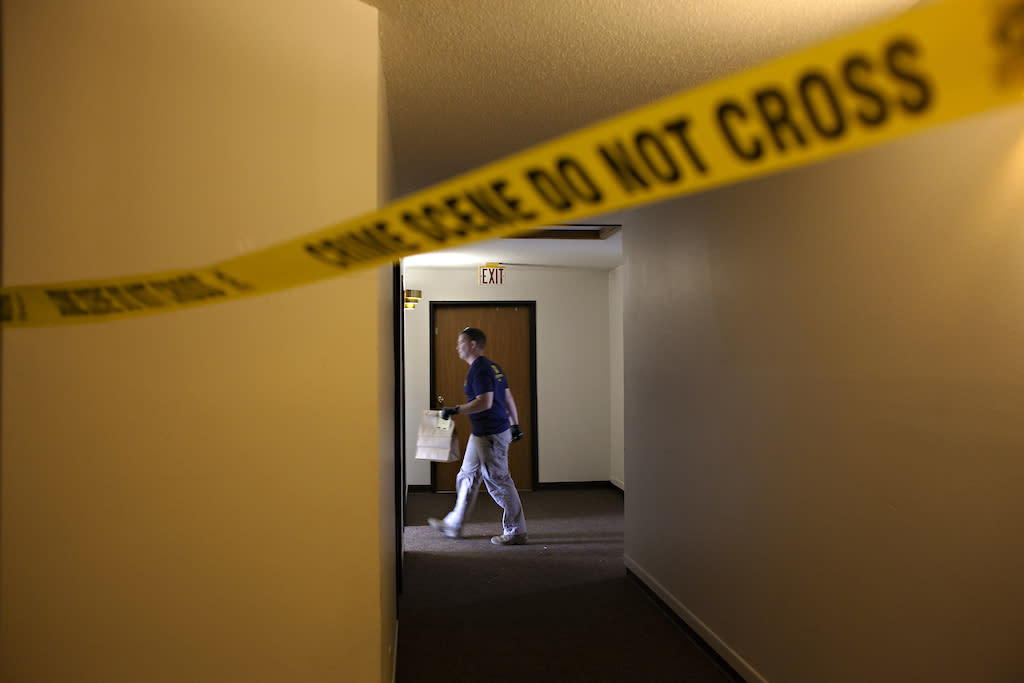Despite what some politicians say, crime rates are decreasing

- Oops!Something went wrong.Please try again later.
- Oops!Something went wrong.Please try again later.
FILE - An FBI Evidence Response Team investigator walks behind crime scene, July 15, 2023, in Fargo, N.D. Data in the FBI's annual crime report released Monday, Oct. 16, 2023 shows that violent crime across the U.S. decreased last year, dropping to about the same level as before the onset of the COVID-19 pandemic. (AP Photo/Ann Arbor Miller, file)
Violent crime in the United States dropped significantly in the first quarter of 2024 compared with the same period last year, according to the FBI’s Quarterly Uniform Crime Report released earlier this month.
The FBI’s data, collected from nearly 12,000 law enforcement agencies representing about 77% of the country’s population, suggests violent crime dropped by 15% compared with the first quarter of 2023.
The data, which covers reported crimes from January to March, shows a 26.4% decrease in murders, a 25.7% decrease in rapes, a 17.8% decrease in robberies, and a 12.5% decrease in aggravated assaults. Reported property crime also fell by 15.1%.
Nevertheless, the widespread public perception that crime is rising — a perception reinforced by presumptive Republican presidential nominee Donald Trump and many other GOP candidates — could figure prominently in November’s election. And state legislative and gubernatorial candidates from both parties likely also will cite crime statistics on the stump.
In a Gallup poll conducted late last year, 63% of respondents described the crime problem in the U.S. as either extremely or very serious. This is the highest percentage since Gallup began asking the question in 2000.
In May, Trump wrongly called FBI data showing a decline in crime “fake numbers.” This month, he erroneously claimed that the FBI’s crime statistics exclude 30% of cities, including the “biggest and most violent.”
He could have been referring to the fact some departments couldn’t report data in 2021 because the FBI switched data reporting systems, but experts say the overall numbers remain valid.
President Joe Biden has also used crime statistics for political gain. In a May campaign email, Biden said that Trump “oversaw the largest increase in murder in U.S. history.” While this is not entirely inaccurate — the country did see the largest one-year increase in murders in 2020 — it omits context regarding the COVID-19 pandemic and the social upheaval following George Floyd’s murder by a Minneapolis police officer.
The latest FBI crime statistics align with other early data from 2024. In May, the Major Cities Chiefs Association released first-quarter data from a survey of 68 major metropolitan police departments showing a 17% drop in murders compared with the same period last year.
The FBI’s latest data is preliminary and unaudited, which means it will change as more law enforcement agencies refine their numbers throughout the year. National crime data is incomplete, as it only includes crimes reported to police, and not every law enforcement agency participates in the FBI’s crime reporting program.
Despite the data’s limitations, some criminologists and crime data experts say the data is reliable. Some say the FBI’s data likely overstates the decreases, suggesting the drop in violent crime is likely less dramatic but still trending downward.
“There’s a lot of uncertainty as to the accuracy of the data, so it matches but probably overstates what the trends are,” Jeff Asher, co-founder of AH Datalytics, a data consulting firm that specializes in crime data, told Stateline in an interview. “In theory, everything will get more accurate as the year goes on.”
Although national data suggests an overall major decrease in crime across the country, some criminologists caution that that isn’t necessarily the case in individual cities and neighborhoods.
“It looks good for the nation as a whole, but even with these great reductions, there are cities in the United States that have likely experienced increases that bucked the trend,” Charis Kubrin, a criminology, law and society professor at the University of California, Irvine, told Stateline.
The average American’s understanding of crime and crime statistics is heavily skewed by media coverage that focuses largely on when crimes are committed and by misleading political rhetoric, according to criminologists and crime data experts.
Instead of relying on statistics, which can feel impersonal, people tend to cling to anecdotes that resonate more emotionally. Politicians take advantage of this, Dan Gardner, author of the book “Risk: The Science and Politics of Fear,” told Stateline.
“If you are a political operative, capitalizing on fear of crime is incredibly easy to do,” Gardner said.
Telling a tragic story and framing it in a way so that voters feel they or their families could become victims of similar crimes unless they vote for a specific politician is a common, highly effective tactic, he added.
This use of fear as a motivator can drive people to the polls, Gardner said, but it also distorts public perception of crime.
“It’s a lousy way to understand the reality of personal safety and society, but it’s a very compelling form of marketing,” Gardner said.
The Council on Criminal Justice, a nonpartisan think tank, released a report this month urging police and the federal government to provide more timely crime data. The report emphasizes that crime data, especially national data, often lags up to a year, which hampers public understanding of crime trends and limits officials’ ability to make informed policy decisions to proactively address public safety issues.
“We need to accelerate improvements in our [crime] data,” John Roman, a senior fellow and the director of the Center on Public Safety and Justice at NORC at the University of Chicago, told Stateline. “The democratization of this data is really critical to more effective policy and programming.”
GET THE MORNING HEADLINES DELIVERED TO YOUR INBOX SUPPORT NEWS YOU TRUST.
The post Despite what some politicians say, crime rates are decreasing appeared first on Oklahoma Voice.

